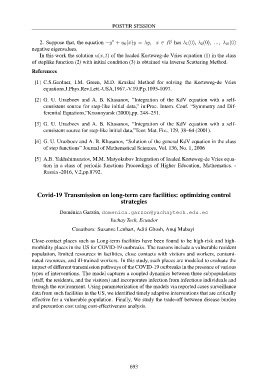Page 695 - 8th European Congress of Mathematics ∙ 20-26 June 2021 ∙ Portorož, Slovenia ∙ Book of Abstracts
P. 695
POSTER SESSION
2. Suppose that, the equation −y + u0(x)y = λy, x ∈ R1 has λ1(0), λ2(0), ..., λN (0)
negative eigenvalues.
In this work the solution u(x, t) of the loaded Korteweg-de Vries equation (1) in the class
of steplike function (2) with initial condition (3) is obtained via Inverse Scattering Method.
References
[1] C.S.Gardner, I.M. Green, M.D. Kruskal Method for solving the Korteweg-de Vries
equations.J.Phys.Rev.Lett.-USA,1967.-V.19.P.p.1095-1097.
[2] G. U. Urazboev and A. B. Khasanov, “Integration of the KdV equation with a self-
consistent source for step-like initial data,” in:Proc. Intern. Conf. “Symmetry and Dif-
ferential Equations,”Krasnoyarsk (2000),pp. 248–251.
[3] G. U. Urazboev and A. B. Khasanov, “Integration of the KdV equation with a self-
consistent source for step-like initial data,”Teor. Mat. Fiz., 129, 38–64 (2001).
[4] G. U. Urazboev and A. B. Khasanov, “Solution of the general KdV equation in the class
of step functions” Journal of Mathematical Sciences, Vol. 136, No. 1, 2006
[5] A.B. Yakhshimuratov, M.M. Matyokubov Integration of loaded Korteweg-de Vries equa-
tion in a class of periodic functions Proceedings of Higher Education, Mathematics. -
Russia -2016, V.2,pp.8792.
Covid-19 Transmission on long-term care facilities: optimizing control
strategies
Doménica Garzón, domenica.garzon@yachaytech.edu.ec
Yachay Tech, Ecuador
Coauthors: Suzanne Lenhart, Aditi Ghosh, Anuj Mubayi
Close-contact places such as Long-term facilities have been found to be high-risk and high-
morbidity places in the US for COVID-19 outbreaks. The reasons include a vulnerable resident
population, limited resources in facilities, close contacts with visitors and workers, contami-
nated resources, and ill-trained workers. In this study, such places are modeled to evaluate the
impact of different transmission pathways of the COVID-19 outbreaks in the presence of various
types of interventions. The model captures a coupled dynamics between three subpopulations
(staff, the residents, and the visitors) and incorporates infection from infectious individuals and
through the environment. Using parameterization of the models via reported cases surveillance
data from such facilities in the US, we identified timely adaptive interventions that are critically
effective for a vulnerable population. Finally, We study the trade-off between disease burden
and prevention cost using cost-effectiveness analysis.
693
2. Suppose that, the equation −y + u0(x)y = λy, x ∈ R1 has λ1(0), λ2(0), ..., λN (0)
negative eigenvalues.
In this work the solution u(x, t) of the loaded Korteweg-de Vries equation (1) in the class
of steplike function (2) with initial condition (3) is obtained via Inverse Scattering Method.
References
[1] C.S.Gardner, I.M. Green, M.D. Kruskal Method for solving the Korteweg-de Vries
equations.J.Phys.Rev.Lett.-USA,1967.-V.19.P.p.1095-1097.
[2] G. U. Urazboev and A. B. Khasanov, “Integration of the KdV equation with a self-
consistent source for step-like initial data,” in:Proc. Intern. Conf. “Symmetry and Dif-
ferential Equations,”Krasnoyarsk (2000),pp. 248–251.
[3] G. U. Urazboev and A. B. Khasanov, “Integration of the KdV equation with a self-
consistent source for step-like initial data,”Teor. Mat. Fiz., 129, 38–64 (2001).
[4] G. U. Urazboev and A. B. Khasanov, “Solution of the general KdV equation in the class
of step functions” Journal of Mathematical Sciences, Vol. 136, No. 1, 2006
[5] A.B. Yakhshimuratov, M.M. Matyokubov Integration of loaded Korteweg-de Vries equa-
tion in a class of periodic functions Proceedings of Higher Education, Mathematics. -
Russia -2016, V.2,pp.8792.
Covid-19 Transmission on long-term care facilities: optimizing control
strategies
Doménica Garzón, domenica.garzon@yachaytech.edu.ec
Yachay Tech, Ecuador
Coauthors: Suzanne Lenhart, Aditi Ghosh, Anuj Mubayi
Close-contact places such as Long-term facilities have been found to be high-risk and high-
morbidity places in the US for COVID-19 outbreaks. The reasons include a vulnerable resident
population, limited resources in facilities, close contacts with visitors and workers, contami-
nated resources, and ill-trained workers. In this study, such places are modeled to evaluate the
impact of different transmission pathways of the COVID-19 outbreaks in the presence of various
types of interventions. The model captures a coupled dynamics between three subpopulations
(staff, the residents, and the visitors) and incorporates infection from infectious individuals and
through the environment. Using parameterization of the models via reported cases surveillance
data from such facilities in the US, we identified timely adaptive interventions that are critically
effective for a vulnerable population. Finally, We study the trade-off between disease burden
and prevention cost using cost-effectiveness analysis.
693


